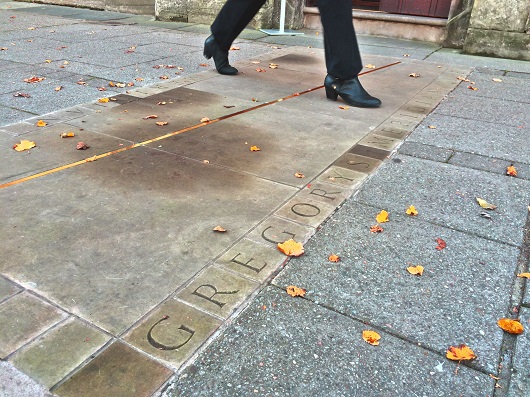St Andrews: Where time began?

The medieval town of St Andrews has staked a claim to unseat Greenwich as the place where time began.
The 17th Century Scottish astronomer and scientific pioneer James Gregory laid down a meridian line across the floor of his lab at St Andrews University in 1673, almost 200 years before the Greenwich Meridian was established and arbitrarily adopted as the world’s official prime meridian.
Now St Andrews has recognised Gregory’s remarkable body of work with a permanent public memorial – a solid brass line which follows exactly the line of his meridian and bisects the pavement in South Street, St Andrews.
As the brass meridian and plaque were unveiled at the site of Gregory’s lab in the King James Library this week, it emerged that St Andrews, and not London, was the place where the world’s hemispheres were first divided.
Gregory’s Scottish meridian runs several degrees west of the Greenwich meridian – and almost 12 minutes behind GMT.
The discovery has far reaching implications for Scots – for over three centuries, they’ve been turning up for work 12 minutes too early, pubs and polling stations have been closing much earlier than they should, traffic wardens may have been too hasty issuing tickets and referees have been blowing for full-time long before the fat lady sings
“The world could today be running on STAMT (St Andrews Mean Time) and not GMT,” said Dr John Amson, Honorary Senior Lecturer in Mathematic at St Andrews University and an authority on Gregory.
“The westward shift of about three degrees of longitude between St Andrews and Greenwich represents a difference of about 12 minutes.
“So the Sun rises over St Andrews after it has done so over London. But then it is that much more a mature Sun!”
The path of the St Andrews Meridian is determined by a wooden line Gregory had set into the floor of the King James Library to delineate the meridian. He used this line in conjunction with a metal sight fixed outside one of the windows, which he lined up with a post on the horizon exactly due south, to make astronomical observations.
In tribute to this forgotten time line, the continuation of James Gregory’s Meridian is now marked on South Street by a brass marker across the pavement outside the University of St Andrews’ King James Library together with a plaque on the wall. These were unveiled this week by University Principal and Vice-Chancellor Professor Louise Richardson together with Chairman of the St Andrews Preservation Trust, Graham Wynd.
Gregory’s Meridian Line also begs the question: where is True East and where is True West? Gregory’s Meridian would place Aberdeen and London in the “Oriental hemisphere”, rather than the Western Hemisphere.
Tourists and townspeople in St Andrews can now stand with one foot in each hemisphere – and set their watches to STAMT.
It’s not clear however if licensing authorities will allow St Andrews hostelries to do the same…
Gregory was appointed the first Regius Professor of Mathematics in 1668 at the age of 30 and was elected a Fellow of the Royal Society the same year. This Scottish mathematician, astronomer and inventor was also one of the three founders of calculus, inventor of the Gregorian Telescope, and the man who discovered the principles of diffraction gratings.
Gregory’s legacy continues with a public lecture series exploring themes of Science and Christianity. This year’s lecture will be delivered tonight by Professor John Wyatt of University College London, in the Physics Department, Lecture Theatre A, 17.15 (Greenwich Mean Time).
NOTES TO NEWS EDITORS
The costs of the meridian line and the plaque have been shared by the University, the Preservation Trust and several other donors.
The Trust’s contribution comes from a fund for the provision of plaques in the town created from a legacy to the Trust from the estate of well-known local historian and worthy, Gordon Christie.
The project has been brought to fruition through the hard work of a number of people; primarily Professor Eric Priest of the University of St Andrews and the Chair of the Preservation Trust’s Plaques sub-committee Colin McAllister.
Images are available from the University of St Andrews press office. To request images please call 01334 462 108.
Dr John Amson is available for interview. To arrange an interview email: [email protected]
Derek A Barrie, Press Officer, St Andrews Preservation Trust, is contactable at: [email protected]
Category Research